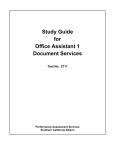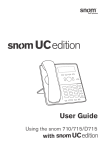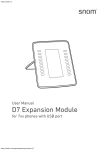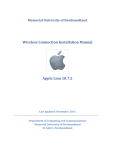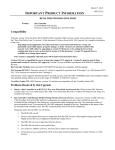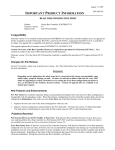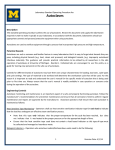Download Autoclave Safe Use - Memorial University of Newfoundland
Transcript
Autoclave Safe Use Standard Operating Procedure BSOP-02 Approved by: IBC Date: Feb 23 2015 1.0 Introduction This Standard Operating Procedure outlines measures for the safe operation, maintenance, repair, and service of autoclaves. These procedures will ensure that Memorial University of Newfoundland’s autoclaves are in compliance with applicable guidelines and regulations. When autoclaves are used to decontaminate biohazardous waste the Disposal of Biohazardous Waste (BSOP-01) procedure must also be followed. 2.0 Scope This BSOP applies to users of all autoclaves owned by Memorial University of Newfoundland. Autoclaves having characteristics which place them under the Newfoundland and Labrador Regulation 119/96: Boilers, Pressure Vessels and Compressed Gas Regulations must comply with all applicable sections on these regulations. 3.0 Responsibilities This section outlines responsibilities within the university for the implementation of this BSOP. a. Environmental Health and Safety (EHS) Maintain an inventory of all autoclaves owned by the University. Ensure that applicable autoclaves are receiving biennial inspections by individuals qualified under the Boilers, Pressure Vessels and Compressed Gas Regulations. Maintain documentation of applicable legislation and update as necessary. b. Department Heads Ensure that supervisors, employees, and students are notified of their responsibilities for working with autoclaves. Notify the DHS of any new autoclaves purchased by their departments, and of the removal of any autoclaves. Ensure that autoclaves undergo regular maintenance. Maintain a record of any necessary Autoclave Logs. Establish department-specific policies as necessary. Post an autoclave operating procedure at the operating station. c. Laboratory Supervisors/Principal Investigators If the autoclave is associated only with your laboratory, be sure to fulfill any applicable responsibilities listed under b. Department Heads. Ensure that autoclave users have received the proper training regarding safe operation, and maintain records of operator training. BSOP02 v1 Date of first issue: Feb 2015 Responsible Committee: Institutional Biosafety Committee Date of last review: Feb 2015 Page 1 of 6 Date of next review: 2018 2015-11-16 For the latest version of this document please go to: http://www.mun.ca/health_safety/OHSMS/BSMS/ Autoclave Safe Use Standard Operating Procedure BSOP-02 Approved by: IBC Date: Feb 23 2015 Report any incidents involving human injury or death, property damage, explosions, or ruptures to the DHS immediately. d. Autoclave Users Follow proper autoclave operating procedures and wear all appropriate personal protective equipment (PPE). Notify the person responsible for the autoclave, as designated by the department, of any malfunctions or other problems. Complete the Autoclave Log with all necessary information each time the autoclave is used. 4.0 Record Keeping Records must be kept in order to track autoclave processes and ensure that autoclaves are meeting regulatory requirements. The following information must be recorded: 1. Autoclave Log: for all autoclaves which are used by multiple labs a log of autoclave use, with each entry containing the date, user, items autoclaved, and time of removal, must be maintained. If the autoclave run is used for decontamination of biohazardous waste, the mass of waste decontaminated must also be documented. These records must be kept for a minimum of three years and be available for inspectors. A template for this log may be found in Appendix A. 2. Problem/Incident Log: a record of any problems encountered. This information can be recorded as part of the Autoclave Log or it can be maintained separately. This should include the results of regular maintenance checks (see Section 6.0). NOTE: Additional records must be kept if the autoclave is used to decontaminate biohazardous waste. See the Management of Biohazardous Waste Standard Operating Procedure (BSOP-01) for template. 5.0 Operation a) Proper personal protective equipment (PPE) must be worn when operating an autoclave to protect against burns and scalds (Figure 1). Shoes with closed toes and heels and lab coats must be worn at all times. If there is a splash risk, goggles and/or a face Figure 2: Heat-insulating gloves shield and a rubber apron must be worn as appropriate. Heat-insulating gloves must be worn when unloading (Figure 2). Figure 1: Autoclave PPE b) When preparing materials for sterilization: BSOP02 v1 Date of first issue: Feb 2015 Responsible Committee: Institutional Biosafety Committee Date of last review: Feb 2015 Page 2 of 6 Date of next review: 2018 2015-11-16 For the latest version of this document please go to: http://www.mun.ca/health_safety/OHSMS/BSMS/ Autoclave Safe Use Standard Operating Procedure BSOP-02 Approved by: IBC Date: Feb 23 2015 All materials awaiting autoclave treatment must be labeled with the name and contact information of the person responsible for the waste, typically the Principal Investigator. Ensure that any primary containers, which are the containers that are in direct contact with the contaminated material, permit steam penetration. Any caps or lids must be loose or partially opened. Autoclave bags should be opened slightly to allow for steam penetration. All containers may be filled to a maximum of half of their capacity. Ensure that secondary containers are used to contain any spill that may occur (Figure 3). Bags must be autoclaved in a Figure 4: No secondary containment Figure 3: Use of secondary containment secondary container to avoid contaminating the chamber (Figure 4). Do not load incompatible materials (oils, waxes, some plastics, flammable materials, radioactive materials, chlorinated substances, corrosive chemicals, substances which may emit toxic fumes, etc.). Be sure that you know which materials can and cannot be autoclaved. c) The autoclave may not be operated at a temperature and/or pressure greater than the one listed in the Boilers and Pressure Vessels Inspection Certificate. d) If a problem is encountered and the load does not undergo the full cycle treatment, then the load must be re-treated with a complete cycle. Record any problems in the Autoclave Log or Problem Log. e) A full operating procedure example may be found in Appendix B. Departments must make the appropriate adjustments to this procedure to match the requirements for the safe use of their autoclave models. Full operating procedures must be located at the operating station and must be available to all users. 6.0 Maintenance Regular Maintenance Check It is recommended that a daily or weekly maintenance check be done as appropriate for the frequency of use as indicated in the autoclaves user manual. Check door gaskets, interior surfaces, screens, containers, exterior surfaces and any other components, if applicable. Clean or disinfect exterior surfaces and clean interior surfaces and screens. BSOP02 v1 Date of first issue: Feb 2015 Responsible Committee: Institutional Biosafety Committee Date of last review: Feb 2015 Page 3 of 6 Date of next review: 2018 2015-11-16 For the latest version of this document please go to: http://www.mun.ca/health_safety/OHSMS/BSMS/ Autoclave Safe Use Standard Operating Procedure 7.0 8.0 BSOP-02 Approved by: IBC Date: Feb 23 2015 Check any primary and secondary containers for cracks, stress fractures, chips, and other damage. Make note of any deficiencies in the autoclave log (Appendix A). It is recommended that all autoclaves receive more formal maintenance by trained personnel, annually or based on manufacturer’s recommendations. Autoclaves must be inspected biennially by an inspector qualified under the NL Regulation 119/96. o A valid certificate of inspection, which must be posted near the autoclave, will be issued after each inspection. o All new autoclaves which fall under the above specifications must be inspected by a qualified inspector before they may be operated. o If you are responsible for an autoclave which falls under the above specifications and is not receiving biennual inspections, please contact EHS. Repairs or Alterations No person shall cover or obliterate any of the markings on an autoclave. Autoclave owners and users may not make repairs or alteration to their autoclaves, unless the steps outlined below are followed. Repair contractors, manufacturers, owners, or users who wish to make repairs or alterations to autoclaves must have written approval from the Chief Inspector, Boiler & Pressure Vessels Division, Service NL. Reporting Incidents When an accident arises out of an autoclave’s operation resulting in injury or death to a person, property damage, or when an explosion or rupture occurs, no person shall alter or move any item at the scene of the incident, until they have been given permission to do so in writing from a Technical Standards and Safety Authority qualified inspector, unless for the purpose of saving a life or relieving human suffering. Incidents of this type must be reported immediately to EHS. EHS will notify Service NL of the incident. Version History: Version 1.0 Date 2015-01-27 BSOP02 v1 Date of first issue: Feb 2015 Author(s) Rod Hobbs Notes First writing. Responsible Committee: Institutional Biosafety Committee Date of last review: Feb 2015 Page 4 of 6 Date of next review: 2018 2015-11-16 For the latest version of this document please go to: http://www.mun.ca/health_safety/OHSMS/BSMS/ Autoclave Safe Use Standard Operating Procedure BSOP-02 Approved by: IBC Date: Feb 23 2015 Appendix A: Autoclave Log Date User Name Principal Investigator BSOP02 v1 Date of first issue: Feb 2015 Time In Time Removed Mass (Kg) Problems Maintenance Encountered Check Responsible Committee: Institutional Biosafety Committee Date of last review: Feb 2015 Page 5 of 6 Date of next review: 2018 2015-11-16 For the latest version of this document please go to: http://www.mun.ca/health_safety/OHSMS/BSMS/ Autoclave Safe Use Standard Operating Procedure BSOP-02 Approved by: IBC Date: Feb 23 2015 Appendix B: Autoclave Safe Operating Procedure Loading Ensure that you are wearing all necessary personal protective equipment (closed toed shoes, insulated gloves, and a lab coat; respirator if applicable). Check that autoclave pressure gauge is at zero and carefully open the autoclave door. Place materials inside the autoclave, in a secondary container (tray) to protect the autoclave (eg. place flasks with liquid inside a deep tray). Make sure not to overload the sterilizer, and arrange items to allowing for steam circulation. Slightly open autoclave bags. Make sure that bags are open to allow for easier steam penetration. Close the autoclave door, making sure that it is properly closed. Fill in the Autoclave Log with all required information. Select the Settings From the control panel, choose the appropriate cycle time and type for sterilization. Start the autoclave. Do not attempt to open the door while the autoclave is running. Make sure that the autoclave reaches the desired temperature before leaving it unattended. If the door begins leaking steam, abort the cycle and tighten the door further. If you must abort, press the abort button on the control panel. Wait for at least a minute before cautiously cracking open the door to let out steam. Once the steam has been release, reopen the door fully. Unloading Once again, be sure to wear all protective equipment [close toed shoes, heat resistant longcuff gloves, and a lab coat; also wear goggles, and/or a face shield, and rubber apron if necessary (i.e. if sterilizing liquids)]. Ensure that temperature and pressure settings for the autoclave run were met and that the gauges are at zero, stand back from the door and crack it open slightly, to allow steam to dissipate before opening it fully. Check for any superheated liquids. If liquids are bubbling, leave them to cool further before moving to avoid boil over. Remove the items and place them in a safe location. Record any problems encountered in the Autoclave Log. NOTE: if using the autoclave to decontaminate biohazardous waste, please refer to BSOP-01 for additional requirements. BSOP02 v1 Date of first issue: Feb 2015 Responsible Committee: Institutional Biosafety Committee Date of last review: Feb 2015 Page 6 of 6 Date of next review: 2018 2015-11-16 For the latest version of this document please go to: http://www.mun.ca/health_safety/OHSMS/BSMS/






